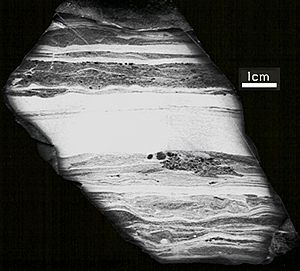Conococheague Formation facts for kids
Quick facts for kids Conococheague FormationStratigraphic range: Cambrian |
|
|---|---|

Etched section of rock from the Conococheague Formation from Washington County, Maryland (dolomite is lighter than the limestone)
|
|
| Type | sedimentary |
| Sub-units | Big Spring Station Member |
| Underlies | Beekmantown Dolomite |
| Overlies | Elbrook Formation |
| Lithology | |
| Primary | Limestone |
| Other | dolomite, sandstone |
| Location | |
| Region | Appalachian Basin of eastern North America |
| Extent | Maryland, Pennsylvania, Virginia, West Virginia |
| Type section | |
| Named for | Conococheague Creek |
| Named by | G. W. Stose, 1908 |
The Conococheague Formation is a special type of rock layer found in the Appalachian Mountains region of eastern North America. It was formed during the Cambrian period, which was a very long time ago! This rock unit is mostly made of two kinds of rocks: limestone and dolomite. You can find it in parts of central Maryland, southern and central Pennsylvania, the Valley and Ridge of Virginia, and easternmost West Virginia.
Contents
About the Conococheague Formation
How These Rocks Formed
The Conococheague Formation rocks likely formed in a shallow ocean or a tidal zone. Imagine a huge, flat area covered by a warm, shallow sea. Over millions of years, tiny bits of shell and other materials settled to the bottom. These layers eventually hardened into the limestone and dolomite we see today.
Where to See These Rocks
You can see the Conococheague Formation in many places. One important spot is near Scotland, Pennsylvania, in Franklin County, Pennsylvania.
You can also find great places to see these rocks along roadsides and rivers. For example, there are good views along I-70 near Hagerstown, Maryland. Here, the rock layers stand almost straight up! This makes it easy to see the different parts of the formation.
The Conococheague Formation also forms tall, 100-foot cliffs along the Potomac River. These cliffs are upstream from Shepherdstown, West Virginia. You can easily see them from the towpath trail of the Chesapeake and Ohio Canal National Historical Park. This trail is on the Maryland side of the Potomac. In Shepherdstown, a monument to steamboat inventor James Rumsey sits on top of one of these cliffs.
Ancient Life in the Rocks
Scientists have found fossils in the Conococheague Formation. These fossils give us clues about the ancient life that existed when these rocks were forming.
- Conodonts: These are tiny, tooth-like fossils from ancient, eel-like creatures.
- Thrombolites: These are dome-shaped structures made by tiny microbes, similar to how coral reefs are built.
- Matthevia: This might be a type of ancient chiton, which is a marine creature with a shell made of several plates. These have been found in a quarry in Bedford County, Virginia.
Age of the Rocks
The Conococheague Formation was formed during the Upper Cambrian period. This means these rocks are incredibly old, dating back hundreds of millions of years!
Images for kids
-
Outcrop along Antietam Creek, near Hagerstown.



